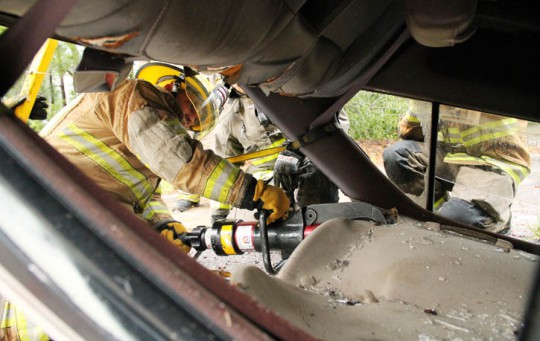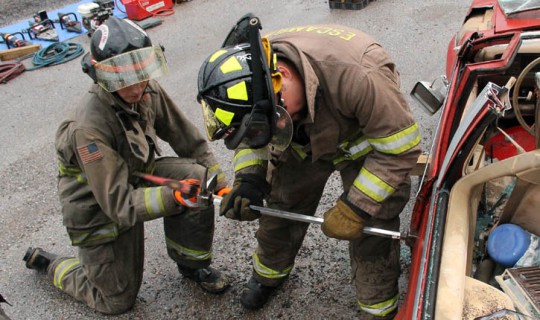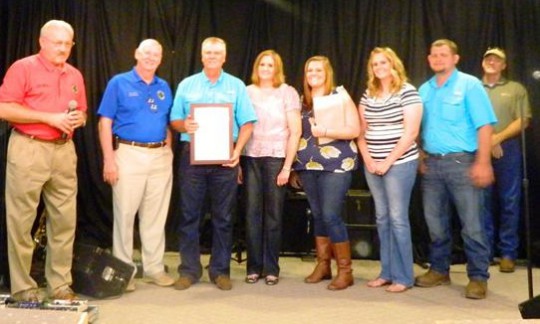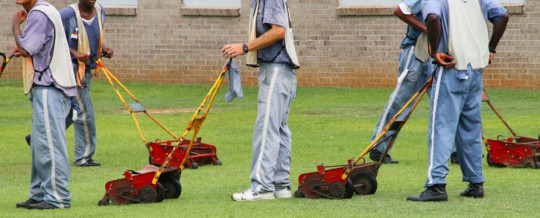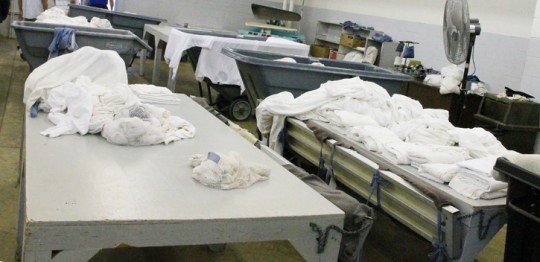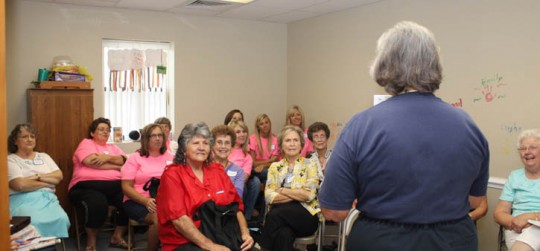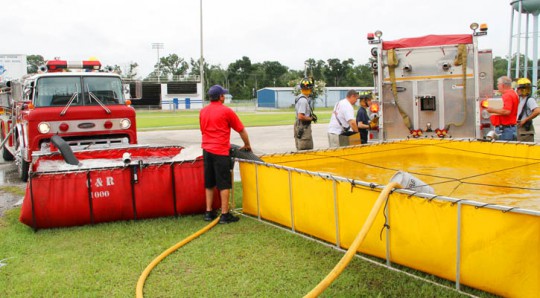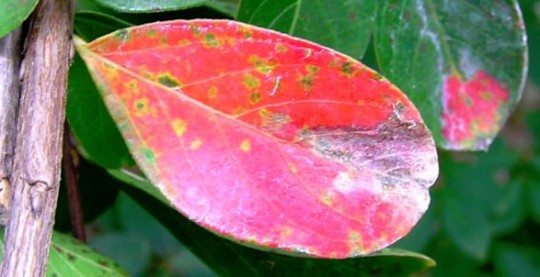4-H Holds Celebration Camp For Navy Kids
July 24, 2013
A 20 local youth members of 4-H recently held four 4-H Celebration Camps at the Langley Bell 4-H Camp in Beulah.
 The youth presented and demonstrated various aspects of 4-H to over 120 children in grades K-3 from the NAS Pensacola and Corry Station child development centers.
The youth presented and demonstrated various aspects of 4-H to over 120 children in grades K-3 from the NAS Pensacola and Corry Station child development centers.
4-H members Izzy, Elise and Jessica talked about their goat and pig projects and the children were given the opportunity to learn about the animals and how much time and effort goes into preparing them for showing. They also demonstrated to the groups that having an animal is a huge responsibility.
Donnie, Jamie, Amanda and Dwayne showed rabbits, and the children were able to get up close with them. The children were able to ask questions and learn about keeping rabbits healthy and how to show them.
Rebekah, Dillon, Alex, Sir, Dominic and Elydia all taught the Children the 4-H Pledge with the words and hand motions. For the older groups they demonstrated how to run a 4-H meeting. They were able to create their own club and hold their own 4-H meeting.
4-H clubs taking part in the event included Barrineau Park, Spectrum, Tech Wizards, Lost Bay, the Lucky Clovers and the Escambia County 4-H Horse Club.
Pictured top: Youth and children from one of the sessions. Pictured inset: Izzy, Jessica and Elise show a goat to the participants. Pictured below: Izzy and Jessica making a presentation. Pictured bottom: Rebekah, president of Escambia County 4-H explains the day to a group of fellow 4-H members. Submitted photos for NorthEscambia.com, click to enlarge.
Photos: Firefighters Practice Vehicle Rescue Skills
July 23, 2013
Firefighters from two North Escambia departments put their vehicle accident rescue skills to the test Monday night in Walnut Hill.
 Members of the Walnut Hill and Century stations of Escambia Fire Rescue held a joint extrication training. In a vehicle extrication, specialized tools coupled with specialized training are used to remove at least a portion of vehicle from around a person following a serious crash.
Members of the Walnut Hill and Century stations of Escambia Fire Rescue held a joint extrication training. In a vehicle extrication, specialized tools coupled with specialized training are used to remove at least a portion of vehicle from around a person following a serious crash.
During the hands on exercise, firefighters practiced using the tools and techniques use during an extrication –including the “Jaws of Life”, spreaders and cutters — on a couple of junked vehicles.
Pictured top: A firefighter uses the Jaws of Life to cut a portion of an overturned vehicle during training at the Walnut Hill Station of Escambia Fire Rescue. Pictured inset: The Jaws of Life are used to force a door open. Pictured below: Firefighters manually pry open a door. NorthEscambia.com photos, click to enlarge.
Campbells Recognized As Santa Rosa Farm Family Of The Year
July 22, 2013
The Keith Campbell family of Chumuckla was honored as the Santa Rosa County Outstanding Farm Family of the Year.
The Campbell farm includes 1,300 acres of cotton, peanuts, wheat, 60 head of beef cattle and an apiary for honey production. The Campbell’s pride themselves on maintaining a family-run, community supported farm that stays on the cutting edge of agricultural progress to reduce costs while increasing total crop yield.
They have embraced numerous technological advancements over the years that have allowed the Campbell farm to thrive and become a mainstay in the Northwest Florida farming community.
In addition to Keith’s wife, Robynn, several other members of the family contribute to the overall success of the farm, including their daughters, Ashleigh, a teacher at Bennett C. Russell Elementary School and Brittney, a student at the University of West Florida; their nephew, Dale Campbell, who helps out after school; and Ashleigh’s husband, Adam Bondurant, a senior at the University of West Florida.
Keith Campbell is a sixth generation farmer. He began farming with his grandfather, W.T. Stewart, in 1983 and has since taken over the entire operation.
The Campbell’s were recognized last week in the U.S. House of Representatives by Congressman Jeff Miller. “My wife Vicki and I wish the Campbell family all the best as they continue to serve the citizens of Northwest Florida,” Miller said.
Courtesy photo for NorthEscambia.com, click to enlarge.
Part 5: Inside Century Correctional – Reel Mowing And Laundry Cents
July 22, 2013
Today, we continue our look inside the Century Correctional Institution with cost savings in the laundry. Our series will continue later this week with a look inside the prison’s most secure housing unit and more.
 Cost savings. That’s what running a state agency in Florida is all about these days. The lawnmowers used inside the fence at Century Correctional Institution look like they are on the last half of their own life sentence. Nobody seems to know just how old they are, but with minimal maintenance and a blade sharpening from time to time, they just keep on going. The old fashioned reel mowers are all prisoner powered, no gas engines here.
Cost savings. That’s what running a state agency in Florida is all about these days. The lawnmowers used inside the fence at Century Correctional Institution look like they are on the last half of their own life sentence. Nobody seems to know just how old they are, but with minimal maintenance and a blade sharpening from time to time, they just keep on going. The old fashioned reel mowers are all prisoner powered, no gas engines here.
(story continues below photo)
The CCI laundry is, obviously, a busy place. The laundry washes all clothes, blankets and linens for the entire main unit population and the nearby work camp. There are 23 inmates assigned to work in the laundry.
The laundry is working toward using their own detergent at a cost of about 2-cents per load. And that’s not where the frugality ends. The laundry makes all their own boxer shorts for the inmate population, and they have recently started using the small and medium size shirts to make larger shirts and pants.
Our series “Inside Century Correctional Institution” continues this week on NorthEscambia.com.
Pictured top: Old fashioned prisoner-powered reel mowers are using on the prison grounds. Pictured above and below: The CCI laundry. NorthEscambia.com photos, click to enlarge.
Over 100 Attend Women’s Conference
July 21, 2013
Over 100 women attended a one-day Women’s Conference Saturday at Ray’s Chapel Baptist Church in McDavid.
Keynote speaker for the event “Unpacking Titus” was Liz Traylor, wife of Dr. Ted Traylor, pastor of Olive Baptist Church in Pensacola. Worship was led by Leah Taylor. Breakout sessions on a variety of topics were led by women from Ray’s Chapel and other churches.
Pictured: “Unpacking Titus”, a women’s conference, held Saturday at Ray’s Chapel Baptist Church in McDavid. Photos by Ramona Preston for NorthEscambia.com, click to enlarge.
Northview Band Washes Its Way Toward The New Season
July 21, 2013
Members of the Northview High School Tribal Beat band held a car wash Saturday in Century to raise funds for the upcoming season. The band must pay may all of its own expenses, including transportation to away football games. NorthEscambia.com photo, click to enlarge.
Featured Recipes: Mexican Sausage Pizza, Sausage Mushroom Calzone
July 21, 2013
A busy life does have to put a damper on dinner plans with these two simple recipes — Mexican Sausage Pizza and Sausage and Mushroom Calzone.
(Scroll down to see both recipes.)
Mexican Sausage Pizza
Prep time: 20 minutes
Cook time: 10 minutes
Makes 4 servings
1 pound roll sausage (can use hot)
3 cups baking mix
2 cups grated cheddar cheese
1 can (15 ounces) refried beans
1/2 cup chopped onion
1 cup diced tomato
1/2 cup minced cilantro
2 cup shredded Mexican blend cheese
Sour cream (optional)
Salsa (optional)
Preheat oven to 350°F.
In medium skillet over medium heat crumble and cook sausage until brown. Cool.
In large bowl, combine baking mix, cheddar cheese and cooked sausage. Stir in 5 or 6 tablespoons water to form a dough. Pat out into a thin layer on a large baking sheet or pizza pan. Bake for 10 minutes or until light brown.
Spread crust with refried beans. Top with onions, tomato, cilantro and cheese. Bake for an additional 10 to 15 minutes or until cheese is melted.
Sausage and Mushroom Calzone
Prep time: 20 minutes
Cook time: 20 minutes
Makes 4 servings
1 pound Italian sausage
1 pound loaf frozen bread dough, thawed
1/2 cup pizza sauce
1 jar sliced mushrooms, drained (4 ounces)
1/2 cup grated mozzarella cheese
Preheat oven to 350°F.
In large skillet, crumble and cook sausage until browned. Set aside.
Roll out dough on lightly floured surface to 12- to 14-inch rectangle. Cut into 4 pieces.
Top half of each rectangle with sauce, sausage, mushrooms and cheese. Fold dough over to enclose. Crimp around edges with a fork. Place on lightly greased baking sheet. Bake at for 20 – 25 minutes or until golden brown.
Photos: Alabama, Florida Fire Departments Conduct Joint Water Training
July 21, 2013
Several area fire departments continued their series of joint training exercises Saturday morning.
 Members of the Atmore Fire Department, Poarch Fire Department, Nokomis (AL) Volunteer Fire Department, McCall Volunteer Fire Department, Appleton Volunteer Fire Department and the Walnut Hill Station of Escambia (FL) Fire Rescue took part in the joint exercise that was all about moving a lot of water quickly.
Members of the Atmore Fire Department, Poarch Fire Department, Nokomis (AL) Volunteer Fire Department, McCall Volunteer Fire Department, Appleton Volunteer Fire Department and the Walnut Hill Station of Escambia (FL) Fire Rescue took part in the joint exercise that was all about moving a lot of water quickly.
Using two 1,500 gallon tankers from Walnut Hill and a tanker from Nokomis, firefighters shuttled water from a hydrant over a half mile away to Escambia County High School in Atmore. The water was dumped into storage pools capable of holding 4,000 gallons, allowing the tanker trucks to support a 500 gallon per minute water flow. The tankers were also used to supply a 1,000 gallon per minute flow.
Firefighters said the exercise allowed the departments to learn how to work together to carryout an operation that would allow them to fight a very large fire using only tanker trucks as a water supply in the event a hydrant was not available.
The city of Atmore does not currently have a tanker truck in its fire department, so the exercise also gave Atmore firefighters a chance to learn more about tanker truck operations.
Pictured top: About 1,500 gallons of water are quickly dumped from a Walnut Hill Volunteer Fire Department tanker truck into a 3,000 gallon storage pool that was being used to supply a 1,000 gallon storage pool and a 500 gallon per minute nozzle Saturday morning at Escambia County High School in Atmore. Pictured inset: Walnut Hill Station Chief Chris Brown adjusts a 1,000 gallon per minute nozzle being supplied by two tanker trucks. NorthEscambia.com photos, click to enlarge.
Birth: Brantley James Sharpless
July 21, 2013

Aaron and Rachel (Martin) Sharpless are pleased to announce the birth of their son, Brantley James Sharpless. Brantley was born on May 30, 2013, at 7:44 am. He weighed 8 lbs. 5 oz., and was 21.5 inches long. Maternal grandparents are Keith and Rochel Martin. Paternal grandparents are Glenn and Jeannie Sharpless.
Great grandparents are the late Frank Stewart Jr., Billy and Joyce Etheridge, Ken and Janette Beck, the late Henderson Robinson, Jack and Betty Sharpless, and the late Frank and Sue Robinson.
Weekend Gardening: Spots On Your Crape Myrtles Can Be A Problem
July 20, 2013
 As the heat and humidity increases in Northwest Florida, expect to see some diseases appear in the landscape. One problem that is popping up on crape myrtles is Cercospora leaf spot. While not a deadly problem, it can greatly detract from the beauty of crape myrtles.
As the heat and humidity increases in Northwest Florida, expect to see some diseases appear in the landscape. One problem that is popping up on crape myrtles is Cercospora leaf spot. While not a deadly problem, it can greatly detract from the beauty of crape myrtles.
The initial symptom on crape myrtles is the appearance of tan to dark brown spots randomly scattered on yellow to red discolored leaves. The spots develop first on the lower leaves and progress upward in the canopy. Spots will continue to develop from mid-summer through fall. The color change is due to the production of a toxin by the fungal pathogen.
Infected leaves will drop prematurely and serve as a source to spread the pathogen causing further disease development. As the summer progresses, many infected trees will have dropped all but the newest leaves.
Older varieties of crape myrtles are more susceptible to this disease than newer varieties. The crape myrtle varieties most tolerant to Cercospora leaf spot are Natchez, Muskogee, Basham’s Party Pink, Sioux and Tonto.
Long term, this disease is not detrimental to a tree, although it will slow down growth on younger plants. Plants growing in conditions that are not ideal will be more affected by the leaf spot disease.
The best control is selecting a planting site with good air circulation so that the foliage will dry quickly. Thinning interior branches will also promote air flow.
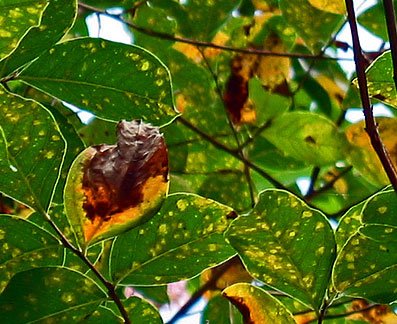 The use of fungicides to control this disease has not been very effective because they would have to be applied repeatedly on a regular basis throughout the growing season. If used, fungicide applications should be started in early summer when the spots are first noticed and continued at one to two week intervals when the weather is warm and wet. Consult your local Extension office for fungicide recommendations.
The use of fungicides to control this disease has not been very effective because they would have to be applied repeatedly on a regular basis throughout the growing season. If used, fungicide applications should be started in early summer when the spots are first noticed and continued at one to two week intervals when the weather is warm and wet. Consult your local Extension office for fungicide recommendations.
As always, be sure to read and follow all label directions. Fungicides can be classified by how they work on the fungus or how they work on the plant. Products that work in a similar way on fungi have the same mode of action (also referred to as chemical family or class).
Contact fungicides are sprayed onto plants and act as a protective barrier from pathogen infection. They prevent infections from occurring when applied before symptoms are visible, but infections that have already occurred will continue to develop.
Systemic fungicides move into the plant, but movement inside the plant is limited. The vast majority of fungicides only move upward in the plant vasculature, but not down. Some fungicides only move locally into the plant part treated. Some systemic products exhibit curative action, which means the disease is stopped during its development. For managing fungicide resistance, products with different modes of action should be used in rotations.
Since this disease will result in early defoliation or the loss of leaves, it is critical to practice good sanitation. Raking and destroying fallen leaves should be a routine practice in order to prevent the spread of the disease.
For more information, contact Theresa Friday at 850-623-3868 or email tlfriday@ufl.edu. Friday is the Residential Horticulture Extension Agent for Santa Rosa County.





